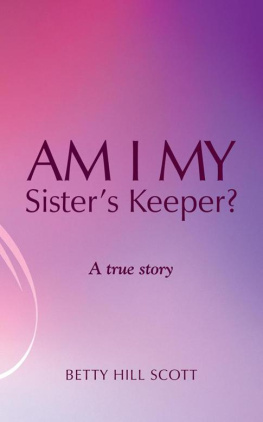2012 Debbie Jones Christensen.
All rights reserved. No part of this book may be reproduced in any form or by any means without permission in writing from the publisher, Deseret Book Company, P.O. Box 30178, Salt Lake City Utah 30178. This work is not an official publication of The Church of Jesus Christ of Latter-day Saints. The views expressed herein are the responsibility of the author and do not necessarily represent the position of the Church or of Deseret Book. Deseret Book is a registered trademark of Deseret Book Company.
Visit us at DeseretBook.com
Library of Congress Cataloging-in-Publication Data
Christensen, Debbie J., author.
As sisters in Zion / Debbie J. Christensen.
pages cm
Summary: British converts and sisters Emily and Julia Hill, assigned to the Willie handcart company, accompany newly widowed Martha Campkin and her five children to Zion. Emily later pens a poem about her experiences that becomes a cherished song of the LDS Relief Society, As Sisters in Zion.Provided by publisher.
Includes bibliographical references.
ISBN 978-1-60908-895-8 (hardbound : alk. paper)
1. Woodmansee, Emily H. (Emily Hill), 18361906. 2. Ivins, Julia Hill, 18331895. 3. Young, Martha Webb Campkin, 18201898. 4. Mormon pioneersBiography. 5. Mormon womenBiography. 6. Mormon handcart companies. I. Title.
BX8693.C47 2012
289.3092'52dc23 2011032601
Printed in the United States of America Publishers Printing, Salt Lake City, UT
10 9 8 7 6 5 4 3 2 1
Frontispiece: Sisters in Zion, by William Whitaker. Used by permission. Courtesy of Craig C. and Debbie J. Christensen.
Photo of Martha Webb Campkin Young courtesy of David Ririe and Steve Jackson. Used by permission.
Photos of Julia Hill Ivins and Emily Hill Woodmansee, courtesy of International Society, Daughters of the Utah Pioneers, Salt Lake City, Utah. Used by permission.

to my sisters Julia, Emily, and Martha
and to Allison, Heather, Robin, Chris, Lana, Marilee, and Christine

As ye are desirous to come into the fold of God, and to be called his people, and are willing to bear one anothers burdens, that they may be light; Yea, and are willing to mourn with those that mourn; yea, and comfort those that stand in need of comfort...
Acknowledgments
I owe deep gratitude to one man and to many strong, virtuous women. It is interesting that a book on sisters was begun because of my husband, Craig. He was the one who initially found their story and who encouraged me to research it and write about it.
I would also like to acknowledge the sisters in my family. Their goodness and example to all who are fortunate enough to cross their paths are an inspiration to me.
Several other good women I would like to acknowledge include Wendy, Sheri, Jana, the Deseret Book publishing team of Leslie, Tonya, and Heather, and my good friends, Jackie and Meaganall who made this book possible.
But above all, I am truly grateful to the sisters, Julia and Emily, who have become dear friends to me throughout this journey.
Chapter One
As Sisters in Zion
Never, never shall I forget that day, surely it was the turning point of my whole life. A few devoted worshippers of truth met together in a small house, to bear their testimony to one another and to worship God!... I did not even ask, What shall I do to be saved. The way was open before me, and simple and young as I was I instinctively knew that I could not err therein.
Emily Hill Woodmansee

In the small town of Warminster, Wiltshire, in southern England, in 1848, there lived a young woman named Emily Hill. Only twelve years old, she was a strong, bright, and creative girl who loved to write poems and study in the family Bible. Even at that young age, she was concerned about her eternal salvation and searched the scriptures. She studied the lives of the ancient prophets, especially Isaiah, and wondered why God didnt speak to man anymore.
One day, a cousin, Miriam Slade, came to visit the Hill family. Miriam was a member of The Church of Jesus Christ of Latter-day Saints, and she told the family about the Church, saying that God had spoken from the heavens to a man named Joseph Smith. She invited the Hill family to attend a meeting the following Sunday. Emilys older sisters laughed and said, Send Em, she will tell us all about it.
The following Sunday, Emily sat enthralled at the message from the missionaries who were preaching, and she instantly recognized that they were talking about the same church that had been established in the days of the Savior Jesus Christ. Emily recollected: It was indeed as though I had been brought out of darkness into marvelous light, and I could not shut my eyes against it.
Of the meeting, Emily wrote, Never, never shall I forget that day, surely it was the turning point of my whole life. A few devoted worshippers of truth met together in a small house, to bear their testimony to one another and to worship God! And He was in their midst and that to bless them.... I did not even ask, What shall I do to be saved. The way was open before me, and simple and young as I was I instinctively knew that I could not err therein.
Thomas Hill, Emilys father, was a wealthy landowner and farmer, and his children were well-educated. He and Elizabeth Slade Hill were the parents of eleven children: Mary Ann (born 1823), Jane (born 1825), Alban (born 1828), Ephraim (born 1830), Charlotte (born 1832), Julia (born January 15, 1833), Frank (born 1834), Emily (born March 24, 1836), twins Esau and Jacob (born 1839, died in infancy), and George (born 1841, died in infancy). Since the three youngest boys had all died in infancy, at the age of five, Emily became the doted-upon youngest living child.
The parents had their own strongly held religious beliefs based in the Wesleyan faith and didnt welcome the message that their daughter brought home from the missionaries. The reverends in the area pressured young Emily, saying that she wasnt old enough to know [her] own mind, and was altogether too young to judge of so grave a matter.
Their strict, Victorian-age parents forbade the girls to join up with the Mormons, a sect that was everywhere spoken against. That such a promise would be made to an obscure young woman from a small town in England was remarkable, particularly as her involvement in the Church was so severely restricted at that time.
The sisters continued to live with their family for the next four years, until 1852, when they determined to join The Church of Jesus Christ of Latter-day Saints. Emily, then sixteen years of age, had a deep and burning testimony of the Restoration, and Julia, nineteen years old and of a quieter nature, held an equally strong conviction. But that didnt make their sacrifice any easier. The sisters clearly understood that the decision to join the Church meant giving up the comforts of their home, the love of their parents, the warmth of their large family circle, and whatever security they had known as daughters of Thomas and Elizabeth Hill. They were baptized on March 25, 1852.















